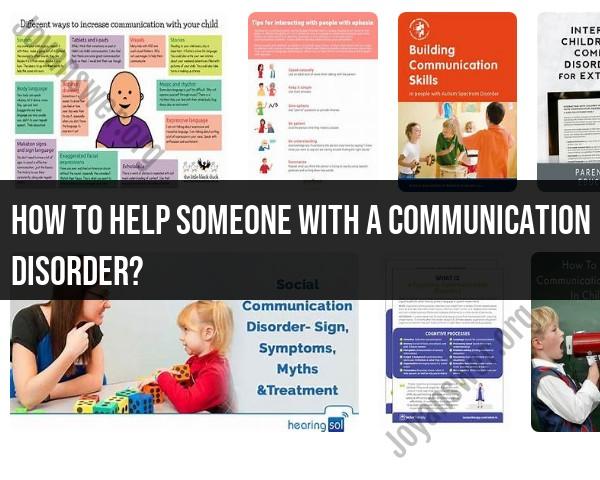How to help someone with a communication disorder?
Supporting someone with a communication disorder involves using strategies that accommodate their unique needs and enable effective communication. The specific approach will depend on the nature and severity of the communication disorder. Here are some supportive strategies:
1. Educate Yourself:
- Learn about the specific communication disorder the person is dealing with. Understand its characteristics, challenges, and potential strategies for improvement.
2. Be Patient and Attentive:
- Give the person sufficient time to express themselves. Avoid interrupting or finishing their sentences. Demonstrate active listening to show that you value their communication.
3. Ask for Preferences:
- Check with the person about their preferred communication methods. Some individuals may use alternative or augmentative communication tools, such as picture boards, sign language, or speech-generating devices.
4. Use Clear and Simple Language:
- Speak in clear, simple sentences. Avoid using complex or ambiguous language. Maintain a moderate pace and pause between sentences to allow for processing.
5. Encourage Non-Verbal Communication:
- Support and encourage non-verbal forms of communication, such as gestures, facial expressions, and body language. Acknowledge and respond appropriately to these cues.
6. Provide Visual Aids:
- Use visual aids, charts, or written instructions to supplement verbal communication. This can enhance understanding and provide additional context.
7. Establish a Communication System:
- Work with the person to establish a communication system that suits their needs. This may involve using symbols, written words, or other visual cues.
8. Create a Supportive Environment:
- Minimize distractions and create an environment conducive to communication. Good lighting, comfortable seating, and reduced background noise can be beneficial.
9. Encourage Expression Through Art or Writing:
- For those who may find it challenging to express themselves verbally, provide alternative means of expression such as art, writing, or other creative outlets.
10. Involve Others:
- Educate family members, friends, and colleagues about the person's communication disorder. Encourage them to use supportive strategies and be patient in their interactions.
11. Supportive Technology:
- Explore the use of technology, including communication apps or devices, that can assist the person in expressing themselves more effectively.
12. Seek Professional Guidance:
- Consult with speech-language pathologists or other professionals who specialize in communication disorders. They can provide tailored strategies and interventions.
13. Advocate for Accessibility:
- Encourage accessibility in public spaces and workplaces. Ensure that accommodations are available, such as assistive devices or sign language interpreters.
14. Promote Social Inclusion:
- Encourage social interactions and provide opportunities for the person to engage with others. Foster an inclusive and supportive social environment.
15. Respect Autonomy:
- Respect the person's autonomy and choices. Avoid making assumptions or decisions on their behalf without consultation.
Remember that each person's experience with a communication disorder is unique, so it's essential to tailor support strategies to their specific needs and preferences. Regular communication and collaboration with the individual and their support network can contribute to a more inclusive and understanding environment.
What strategies or support can be provided to individuals with communication disorders?
Individuals with communication disorders face unique challenges in expressing themselves and understanding others. Fortunately, various strategies and support systems can help them achieve their full potential in communication and interaction. Here are some effective approaches:
1. Speech-language therapy:
- Individualized assessments: A qualified speech-language pathologist (SLP) conducts thorough assessments to identify the specific communication needs and challenges faced by the individual.
- Therapeutic interventions: Based on the assessment, an SLP develops a personalized treatment plan that addresses specific areas of difficulty. This may include:
- Articulation therapy: Focuses on improving the production of speech sounds.
- Language therapy: Targets vocabulary development, grammar, syntax, and pragmatic skills like turn-taking and conversation skills.
- Augmentative and alternative communication (AAC): Introduces tools and methods to enhance communication beyond spoken language, such as picture symbols, electronic devices, and sign language.
2. Educational support:
- Individualized education programs (IEPs): For children with communication disorders in school, IEPs provide tailored educational plans with specific accommodations and support services, such as:
- Speech-language therapy within the school setting.
- Preferential seating arrangements to optimize communication.
- Modified assignments or testing formats.
- Extended time for completing tasks.
3. Assistive technology:
- Communication devices: Electronic devices with voice output or text-to-speech capabilities can significantly enhance communication for individuals with speech difficulties.
- Computer software: Programs with features like word prediction, spell-check, and voice recognition can assist individuals with writing and communication tasks.
4. Social and emotional support:
- Individual or group counseling: Can help individuals cope with the challenges of communication disorders and develop self-esteem and resilience.
- Support groups: Connecting with others who share similar experiences can provide valuable understanding, empathy, and encouragement.
5. Family involvement:
- Family education and training: Equipping families with knowledge about communication disorders and effective communication strategies can significantly support their child's development and well-being.
- Collaborative communication: Encouraging open and honest communication within families fosters a supportive environment and facilitates the individual's progress.
Additional resources:
- American Speech-Language-Hearing Association (ASHA): https://www.asha.org/
- National Institute on Deafness and Other Communication Disorders (NIDCD): https://www.nih.gov/about-nih/what-we-do/nih-almanac/national-institute-deafness-other-communication-disorders-nidcd
- Stuttering Foundation: https://www.stutteringhelp.org/
- CommunicationFIRST: https://communicationfirst.org/
It's crucial to remember that the specific strategies and support required will vary greatly depending on the individual's age, communication disorder, severity, and personal needs. A collaborative approach involving healthcare professionals, educators, family members, and the individual themselves is vital to ensuring effective communication support and maximizing their potential.













